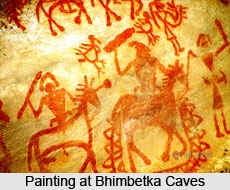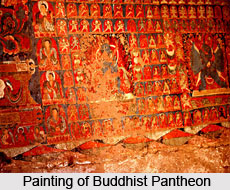 Indian cave paintings are of utmost importance due to the lack of proper documented and written records of prehistoric period. Moreover, Indian cave paintings have more durability than most other forms of paintings and are comparatively safe from general wear and tear that gravely affects paper, fabric, wooden or other form of ancient art. Indian caves provide the adequate setting for preservation of ancient paintings by means of which an idea about the ancient way of life and society can be obtained.
Indian cave paintings are of utmost importance due to the lack of proper documented and written records of prehistoric period. Moreover, Indian cave paintings have more durability than most other forms of paintings and are comparatively safe from general wear and tear that gravely affects paper, fabric, wooden or other form of ancient art. Indian caves provide the adequate setting for preservation of ancient paintings by means of which an idea about the ancient way of life and society can be obtained.The blessed topography of India comprises of adequate landscapes that provide the perfect setting for cave paintings and other rock-cut sculptures. Approximately, there are almost 1500 separate caves in the country at present, and more new caves are being exhumed with the course of time. The Deccan Plateau of India comprises of granite, Basalt, diorite which is extensively available in the area. Deep caves provide the idyllic protection from various elements, for the diverse culture and creative styles in Indian cave paintings.
Religious Cave Paintings in India
Various natural rock-cut caves of India usually contain ancient and prehistoric cave art and paintings which is spread though out the country from the Himalayas to the southern part of India. The Rock Shelters of Bhimbetka in Madhya Pradesh are of outstanding importance as there are around 500 caves and rock shelter which contain numerous paintings. The earliest painting may be as old as 15,000 years and it shelters some of the most primitive paintings created by humans around the world. The earliest petroglyphs are also located in here which may be almost 290,000 years old. The Ajanta Caves also contains very old paintings that can be dated back to 1st century BC, although most of the other paintings are originally from 460 - 480 AD. The murals in the Ajanta are famous for Buddhist art which centre on the life tales of Lord Buddha.
 Various mythical creatures like Nagas, Yakshas, Vrikshikas, and also other goddesses. The unique artworks of Jogimara Cave in Chhattisgarh, which were made around the 1st century BC, are not linked with religion, unlike most other Indian Cave Paintings, instead they portray images of elephant, fish and dancing couples.
Various mythical creatures like Nagas, Yakshas, Vrikshikas, and also other goddesses. The unique artworks of Jogimara Cave in Chhattisgarh, which were made around the 1st century BC, are not linked with religion, unlike most other Indian Cave Paintings, instead they portray images of elephant, fish and dancing couples.In Maharashtra, the Pitalkhora Caves were ornamented with artistic paintings that belong to the 4th century AD and these have been preserved till now. More stunning paintings are conserved in Bagh Caves, Madhya Pradesh, which also date back to 4th - 6th century AD. The paintings in the Badami Cave Templesof Karnataka, approximately from late 6th - 7th century AD, portray paintings of Lord Brahma riding his swan. In Orissa, Ravan Chhaya rock shelter, also hosts remarkable testament of art of the tempera painting style. The Ellora Cavesof Maharashtra are also of great importance as five caves enclose remnants of ancient Indian painting. The striking murals of the Cave 32 and 33, which are from the 9th- 11th century, mark the origin of the medieval era Indian painting. The paintings in the Kailasanatha temple are conserved in a better state.
For more, visit the link below: